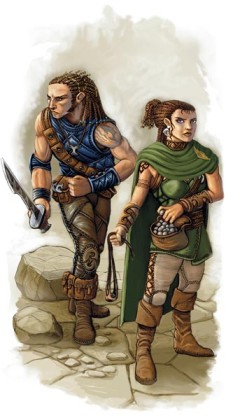
![]() Ever find yourself drowning in the ocean of text of some powers or magic items? And miss that one word that changes how the entire thing works? Or found flavor descriptions severely lacking? Wish there was a better way to both view and read power and magic item cards?
Ever find yourself drowning in the ocean of text of some powers or magic items? And miss that one word that changes how the entire thing works? Or found flavor descriptions severely lacking? Wish there was a better way to both view and read power and magic item cards?
As I told Robert J. Schwalb in his excellent The Burden’s On You:
This happens a lot with us. You’re absolutely right about 4e’s precision. It’s so easy to miss out on a specific part of a wall of text of rules. Often, that one short sentence changes the dynamics, utility and power level of something altogether.
I often wish 4e’s powers, feats and similar features had bulleted information for easier “decoding.” Prose and walls of texts is not a good fit for 4e’s tactical complexity.
Whether it’s for D&D 4e or 5e, the quest for more efficient formatting and more inspiring text on power and magic item cards begins now!
Bullets vs. Paragraphs
With how much more tactically rich and conditions-consistent 4e combat is, a bulleted list of powers’ impact and effects is better than some of those awful “walls of text” you see on some powers and magic items.
It’s a readability and speed-of-readability thing.
And with longer 4e combats, give me more readability and speed-of-readability!
I cringe when a player sometimes literally reads their entire wall-of-text power aloud to everyone. (You have someone like this in your group, don’t you?)
Doing so a) slows down the game, b) suggest the power is a bit too complex or overly wordy, and/or c) suggests the player doesn’t understand the power or wasn’t prepared.
Maybe not every power or magic item could use a bullet approach. But some of them at least? Absolutely.
Flavor Description Length
The fluff and flavor are a separate but equally important issue. Typically it’s short in 4e for brevity, saving print space, and encouraging our own imagination to expand on or re-flavor the fluff. Sometimes the brevity is a bit too extreme on powers or magic items, though, giving you very little of five senses-worth of information that help visualize the power or item.
Some of those lavish, rich, multi-sensory descriptions of and lore surrounding powers, magic items, and monsters (until recently, with releases like Heroes of Shadow, the Monster Vault series, and the highly anticipated upcoming Mordenkainen’s Magnificent Emporium), are sorely missing in 4e, and they do add that important touch of flavor to the game that helps with visualizations and spurring the imagination – a key part of D&D since… well, forever.
In prior editions, flavor and rules text were all tossed together in the same handful of paragraphs. This, too, had its readability drawbacks, especially when looking for specific tactical info. But haven’t we gone too far now? Where’s the flavor?
Customizing the Future of Power Cards
Here’s the two big things I’d like to see supported by the Character Builder in our power cards’ presentation: a bullets option and a a power “strip” option.
Bullets. Deep dive all those powers and magic items and recreate them with a bulleted format that’s more readable, similar to my D&D 4e Buff Cards. Bulleted information is simply faster and easier to comprehend, add up and execute, especially when it comes to all the numbers and tactical buffs of D&D combat.
Power Strip. The ability to choose a “strip” over a “card” format – so you can have rows of powers printed out in front of you, rather than cards. This may make powers more readable for some players, and save some page-flipping. The row-style “spell” description is not new – you can find it in prior editions, just not in 4e, yet!
And of course, these two things are not mutually exclusive. I envision power strips with flavor on the far left in a small paragraph and bulleted tactical information in small columns to the right of that.
Creating Character Builder 2.0
Of course now the question becomes – how hard are these options to code within the Character Builder? And how important is adding more customizable Character Builder and character sheet options like these which focus on readability and usability?
Just like you see with digital apps and in all learning, the amount of the user’s direct control over the presentation of information is king. If the play’s the thing, as it truly is with 4e, then why shouldn’t we expect more options like these from the Character Builder?